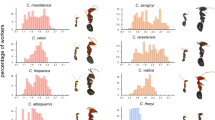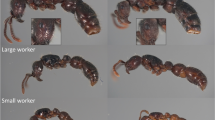Summary.
Division of labour is associated with morphological specialization in many species of social insects. Comparative data on phylogenetically "primitive" ants can help understand the selective forces promoting the production of multiple worker castes as well as the morphological divergence between queens and workers. We quantified size variations among workers and queen-worker dimorphism in the Myrmeciinae ant Myrmecia gulosa. Worker size varies over a wide range (14–23 mm), exhibiting a bimodal distribution. Growth is monophasic and only slightly allometric. Workers do not perform trophallaxis but lay trophic eggs, which constitute the main channel of food exchange in the colony. Large individuals have more ovarioles than small individuals and lay more trophic eggs. The difference in egg output persists when orphaned workers start to reproduce. Although small workers are less fecund, they reproduce more readily than large individuals following queen removal. Queens are not much larger than the largest workers, but have disproportionately more ovarioles and have a 10-fold higher egg-laying rate than workers. We examine size frequency distribution and bi-logarithmic plots of head and gaster measurements in order to infer the developmental processes that generate divergence in size and proportion among colony members. The appearance of two classes of workers in M. gulosa has not been accompanied by a loss in reproductive potential as in some "higher" ants. We review the morphometric studies available for Myrmecia, and discuss the evolution of morphological specialization in the genus.
Similar content being viewed by others
Author information
Authors and Affiliations
Additional information
Received 7 January 2002; revised 24 April 2002; accepted 29 April 2002.
Rights and permissions
About this article
Cite this article
Dietemann, V., Hölldobler, B. & Peeters, C. Caste specialization and differentiation in reproductive potential in the phylogenetically primitive ant Myrmecia gulosa . Insectes soc. 49, 289–298 (2002). https://doi.org/10.1007/s00040-002-8316-9
Issue Date:
DOI: https://doi.org/10.1007/s00040-002-8316-9




